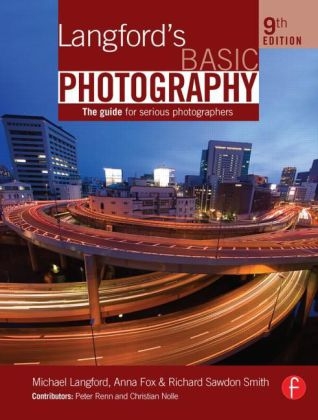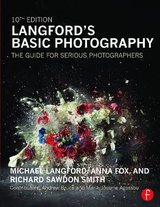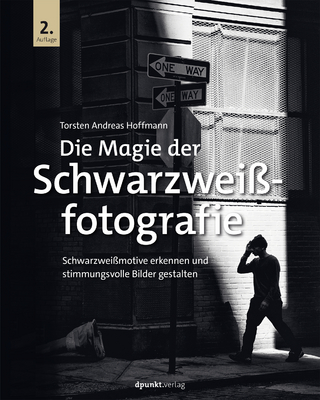
Langford's Basic Photography
Focal Press (Verlag)
978-0-240-52168-8 (ISBN)
- Titel erscheint in neuer Auflage
- Artikel merken
Langford's Basic Photography is a seminal photography text. First published in 1965, it has informed the work and career of many of the world's leading photographers.
The new, 9th edition, continues the tradition of its predecessors, reflecting the same comprehensive mix of scholarly and practical information. It covers every aspect of photography, from capture through to output, both digital and analogue. There is an emphasis on explaining the 'how to' of photography, but Langford's Basic also includes in-depth coverage of the fundamental principles that govern the art, such as how light behaves, optics, and the shutter. This ensures that the reader comes away with not only a good grasp of photographic technique, but also an in-depth understanding of the fundamentals that will help them to better understand how great photography is made. As such, it functions both as an excellent coursebook for students of photography, and a great primer and reference for amateur enthusiasts.
The new edition has been fully updated to reflect dynamic changes in the industry. These changes include: an expansion and overhaul of the information on digital cameras and digital printing; an emphasis on updating photographs to incude a wider range of international work; replacement of many diagrams with photos; overhaul of the analogue sections to give a more modern tone (ie exposure measurement and film and filters with some more dynamic photo illustrations); a fully edited and updated photography timeline.
This landmark text is an essential purchase, both for new photographers as an introduction, and for established photographers as an invaluable reference work.
Michael Langford, renowned author, teacher, and practitioner, is a legend because of his skill that balanced art and technique. He inspired and taught thousands. As Photography Course Director at the Royal College of Art, London, UK, his key involvement with photography courses and exams set the standard worldwide.
1. What is photography? Why photography? How photography works. Picture structuring. The roles photographs play. Changing attitudes towards photography. Personal styles and approaches. Measuring success. Summary. Projects. 2. Light: how images are formed. Light itself. Wavelengths and colours. Shadows. When light reaches a surface. Light intensity and distance. Making light form images. Summary. Projects. 3. Lenses: controlling the image. Photographic lenses. Aperture and f-numbers. Depth of field. How depth of field works. Depth of focus. Image stabilization. Lenses for digital camera. Lens care. Summary. Project. 4. Cameras using film. The essential components. Camera types – which is best? How view cameras work. How direct viewfinder cameras work. How reflex cameras work. Summary. Projects. 5. Using different focal length lenses, camera kits. Why change focal length? Lens kits. Close-up equipment. Essentials and extras. Right for the job. Summary. Projects. 6. Digital cameras. How are digital images captured? File formats. Digital cameras. Summary. Projects. 7. Lighting: principles and equipment. Basic characteristics of lighting. Lighting equipment. Practical lighting problems. Special subjects. Summary. Projects. 8. Organising the picture. Noticing subject feature. Structuring pictures through the camera. Where photographs go. Summary. Projects. 9. Films, filters. Silver halide emulsions. Features common to all films. Choosing films for black and white. Films for colour photography. Storing film – before and after exposure. So which film is `best’? Filters – how they work. Filter kits. Summary. Projects. 10. Exposure measurement. Factors that determine what exposure to give. Exposing different film types. Measuring exposure (continuous light). Practical exposure tips. Measuring exposure for flash. Practical flash exposure tips. Summary. Projects. 11. Film processing. Equipment and general preparations. Processing black and white (silver image) negatives. Processing chromogenic (colour and black and white) negatives. Processing colour slides and transparencies. Processing other film materials. Processing by machine. Permanence of processed results. Summary. Projects. 12. Black and white printing: facilities and equipment. Darkroom organisation. Equipment: the enlarger. Printing papers. Safelighting and printing paper sensitivity. Processing procedure. Summary. Projects. 13. Black and white printing: techniques. Making contact prints. `Straight’ enlarging. Controls during enlarging. Variations. Common print faults. Chemical afterwork. Toning. Tinting. Retouching. Permanence and archiving. Summary. Projects. 14. The digital image: post-production. Overview. Hardware. Software. Organising your work. Saving your digital file. Basic editing. Advanced editing. Summary. Projects. 15. Finishing and presenting work. The permanence of prints. Mounting methods and framing. Spotting. Getting your work noticed. Pictures on the World Wide Web. Building your own site. How to get connected. Summary. Projects
| Erscheint lt. Verlag | 23.7.2010 |
|---|---|
| Zusatzinfo | 645 |
| Verlagsort | Oxford |
| Sprache | englisch |
| Maße | 189 x 246 mm |
| Gewicht | 1293 g |
| Themenwelt | Kunst / Musik / Theater ► Fotokunst |
| Sachbuch/Ratgeber ► Freizeit / Hobby ► Fotografieren / Filmen | |
| ISBN-10 | 0-240-52168-4 / 0240521684 |
| ISBN-13 | 978-0-240-52168-8 / 9780240521688 |
| Zustand | Neuware |
| Informationen gemäß Produktsicherheitsverordnung (GPSR) | |
| Haben Sie eine Frage zum Produkt? |
aus dem Bereich



